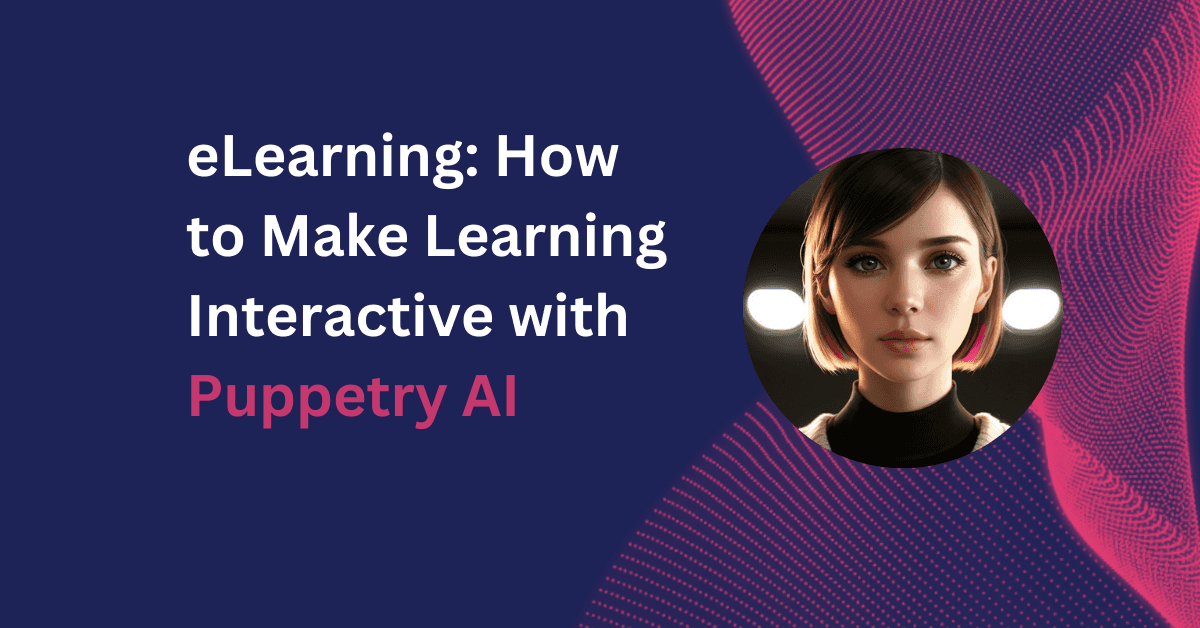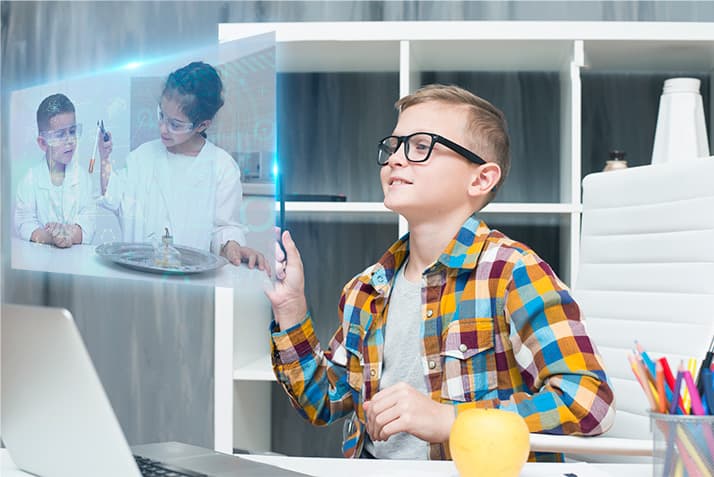
How to Make Learning Interactive with Puppetry AI
Learn how to make learning interactive with Puppetry and invite learners to become partners in creating, exploring, and growing their educational experiences.
While traditional teaching methods remain the industry’s bread and butter, AI-powered interactive learning technologies are moving front and center.
AI interactive learning brings textbooks to life, allows historical figures to step out of pages, and facilitates complex equations to dance. This innovative teaching strategy engages eager minds. Yes, even adults.
So, how can you transcend the conventional lecture-style approach? With Puppetry, of course!
Learn how to make learning interactive with Puppetry and invite learners to become partners in creating, exploring, and growing their educational experiences.
So, buckle up, and let’s dive into the art of artificial intelligence interactive and visual learning with Puppetry.
What Is Interactive Learning?
You’re not alone in asking, “What is interactive learning?”
It’s easy to get lost with the various teaching-learning strategies, including theories and models.
The best way to appreciate interactive learning is to consider the teaching-learning experience a two-way street.
Teachers share knowledge, and learners absorb it.
More importantly, a feedback loop is ever-present.
Students can ask questions, interact with teachers and other learners, and participate actively in learning activities.
Technology is crucial in facilitating interactive learning.
Teachers can devise games and concoct stories to drive learning concepts.
And that’s where AI learning technologies are vital. Well-thought-out AI learning interactions can promote optimal learning and contribute to learner development. Puppetry can help.
How to Make Learning Interactive with Puppetry AI Tutors
Puppetry is an easy-to-use AI video generator empowering teachers, instructors, trainers, and anyone in the teaching-learning industry to create AI interactive learning experiences. But how can you make one?
1. Start with learning objectives.
What do you want students to learn? Are you following a recommended curriculum or course syllabus?
The point is to identify the learning objectives to guide you in mapping the flow of concepts, ideas, principles, and other knowledge.
It also empowers you to determine the parameters for measuring whether students learned something.
Did they understand the message, or must you provide other AI learning examples?
Learning objectives also help determine how you want to impart knowledge.
Do you need AI interactive games to supplement other learning activities?
How about interactive AI learning modules your students can read and appreciate at their convenience?
2. Create a video script.
Having a video script is crucial for developing AI e-learning activities.
It is similar to how a Hollywood scriptwriter creates a screenplay by outlining storylines, settings, situations, characters, and other elements.
The good news is that creating a script becomes effortless when you have clear learning objectives. If you experience writer's block, Puppetry's integrated ChatGPT tool can be helpful.
You can input simple instructions or prompts in the tool to allow Puppetry’s intuitive AI technology to generate compelling content to add to your script.
3. Generate and animate an AI puppet or image.
Log into Puppetry and find Studio in the Menu.
You will need the Animator to create an interactive learning AI puppet.
Puppetry has AI-generated images or faces to pick, animate, and turn into your AI interactive learning facilitator or instructor.
Can’t find a “face?” No problem!
Puppetry lets you upload an image or create one from its puppet or image generator.
Pick a style or ethnicity.
Select a suitable color for the hair, skin, and lipstick.
Add your script by clicking the “Animate with Text” field.
Please note Puppetry limits the text to 3600 characters.
Alternatively, you can upload an audio recording to add to the video.
Most instructors, teachers, and trainers prefer this trick because it allows them to “personalize” the AI eLearning content.
Here's how you can personalize your AI avatar in Puppetry.
4. Refine and publish the video.
You must refine the AI interactive learning video to make it engaging for the learners.
You can share the video with your colleagues and ask for their feedback and constructive criticism.
Once you are satisfied with the interactive learning AI video, you can share it with the learners in the virtual classroom, via email, or in a private social media group.
Essential Elements of an Effective AI Interactive Learning Content
Puppetry makes creating AI interactive lessons more fun and engaging.
Unfortunately, you have to plan your teaching-learning strategy.
Puppetry and other AI-powered digital content development platforms still require your input.
So, what elements are crucial to effective AI interactive learning content?
Storyboard or script
Interactive e-learning content is only as effective as the storyboard.
Puppetry can create stunning visuals, but the message will come from you.
The flow of information must be fluid and meaningful.
Learners must grasp ideas and principles within the video’s limited time frame.
Compelling graphics and visuals
Would you watch a film with blurry shots, dull colors, and boring background? No?
Your learners don’t want the same experience with your interactive AI learning videos.
The graphics must be as stunning as the storyline is compelling. Otherwise, students will lose interest, and you won’t achieve the learning objectives.
Interesting Read: Top 6 Benefits of Visual Learning | An Educator's Guide 2024
AI avatars
Digital avatars are a crucial element in interactive learning methods. These virtual characters add a face to concepts, theories, and principles.
Using an AI tutor is like having a teacher in front of the camera interacting with learners.
Hence, the AI puppet must be as realistic as possible, although children might prefer their favorite cartoon characters to deliver the learning content.
Learn how to use AI avatars in education to make them more effective.
Benefits of Interactive Learning for Students
Learning interactive courses can bring many benefits to students, including adults. Let’s look at the key benefits of interactive learning in the classroom or any setting.
Active engagement
The issue with lectures is not everyone listens.
Some might appear to listen, but their minds wander.
Interactive learning requires learner input, making them engage with the platform more actively.
Improved comprehension
The more engaged learners are with their activities, the better they are in understanding and appreciating learning messages.
Enhanced critical thinking
Interactive learning often removes a live person from the picture.
Students can perform AI e-learning activities at their convenience – at home, on the bus, on a cruise ship, or a vacation home.
The lack of teacher supervision can encourage out-of-the-box critical thinking.
Improved communication and collaboration
Lectures can be primarily a one-way street. Instructors babble, and learners listen.
AI learning by interacting requires input from teachers and students, allowing the latter to improve communication skills and the ability to work with others.
Longer memory retention
The US Department of Education revealed that interactive learning stimulates our visual centers better than other methods. This observation enhances memory retention.
Challenges of Creating AI Interactive Educational Videos
Although Puppetry can help create effective AI interactive educational materials, teachers and instructors must face the following challenges.
Learner attention span
The average student can focus on learning content for 10 to 15 minutes, less if your lessons aren't interactive enough.
That's why instructors must develop content to grab attention and ensure learners stay glued to the activity.
Diverse learning styles
Did you know people learn new information through one of four general learning styles?
Besides visual, kinesthetic, reading/writing, and auditory, people can be logical or analytic, social or linguistic, solitary, or nature learners.
Different types of interactive learning exist to accommodate these learning styles.
Handling questions
Although AI learning robots can answer virtually any question by scouring the Net for the most credible solutions, teachers must still check the subject's appropriateness.
Sometimes, questions require an instructor’s views from life-long experiences. No machine can replace or replicate real-life learning.
Frequently Asked Questions
Why is interactive learning important?
Interactive learning engages students, promotes better knowledge retention, fosters creative and critical thinking, encourages independent learning, and enhances the learning experience.
What is adaptive learning in artificial intelligence?
AI technologies are continuously evolving.
They analyze learner-platform interactions, assessment outcomes, learning progress, and other learner data to develop actionable insights for teachers and instructors to improve the teaching-learning content.
Is interactive learning better than traditional methods?
Interactive learning is more effective than traditional lectures because it encourages active learner participation.
It’s like learning by doing, allowing students to appreciate abstract principles and concepts in real life.
Conclusion
Making interactive learning lessons and activities with Puppetry is as effortless as tapping several buttons.
Planning lessons and transcribing essential concepts into a storyboard can be challenging.
The good news is that Puppetry handles everything else.
Your only task is to share the content with your learners on their favorite channels and monitor their progress. That sounds straightforward enough.
Related Articles
Discover more insights and expand your knowledge with these hand-picked articles

How to Turn Any Webpage Into a Stunning Video: Step-by-Step with Puppetry AI
With Puppetry’s advanced yet fun AI video generator, turning your favorite webpages into scroll-stopping videos is now a thing.

How to Create Corporate Training Videos with AI (and Why It’s a Total Game-Changer)
Discover ways that Puppetry AI can revolutionize the creation of corporate training videos. So, if you’re ready to engage your team with interactive, memorable, and cost-effective learning experiences with AI-powered puppets, read this today!

Unlocking the Power of AI Tutor in Visual Education: The Future of Learning with Puppetry
AI now also helps in visual education. Learn how you can use AI to improve your teaching process.
Ready to Create Amazing Content?
Join thousands of creators who use Puppetry to bring their ideas to life. Start creating engaging content today with our AI-powered platform.